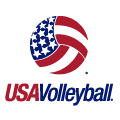Women’s Volleyball Recruiting Guidelines: What Coaches Look for

Coaches aren’t just recruiting athletes based on their size—they also have a list of skills those recruits need to execute, such as vertical jump, standing reach, attack jump and approach jump. We worked with our partner the American Volleyball Coaches Association to get numbers around these volleyball-specific measurements. AVCA has hosted combines and tested volleyball players during college tournaments at all division levels. They compiled the data in their avcaVPI™ database to provide the average scores of college-level volleyball players, plus the scores in the top 80th percentile. We’ve included these numbers below to give families a good idea of where athletes need to be at to compete at the college level—and at the most competitive level.
Quick Links
How to use the volleyball recruiting guidelines
To get an idea of what it takes to be a college volleyball player, athletes need to consider multiple factors. These desired measurables for their position and necessary club experience. Here’s why each of these factors are important to include:
- Club and high school experience: In volleyball, club experience is one of the most important factors in the recruiting process. Not only does club participation increase an athlete’s likelihood of getting noticed by college coaches, but it also shows coaches that athletes have been tested against some of the best volleyball players in the country. Within the club volleyball scene, there are different levels of competitiveness. Athletes interested in competing at a D1 college need some experience competing at the most elite level of club competition to prove they’re ready for the rigors of D1 play.
- Volleyball-specific stats: When coaches evaluate recruits, they do a quick check of their height, block jump, approach jump, attack jump and standing reach (position dependent) to make sure recruits have the baseline requirements for playing at that school. However, the requirements that coaches look for will change slightly from school to school. These guidelines represent an overall average, based on data from the AVCA, as well as the top 80th percentile. Athletes should also check in with college coaches of interest to discover what their specific requirements are for recruits.
These guidelines aren’t going to answer every question on how good an athlete needs to be, but they are meant to be used as just that: guidelines. Families should use them to get a better understanding of what division levels their athlete is best suited for.
Volleyball recruiting tip: College coaches are always interested in seeing a recruit’s third-party verified stats. This shows the coach that an impartial measurer accurately captured these numbers, versus the recruit inventing them or taking them on imperfect equipment. The easiest way to get verified numbers is to go to the AVCA College Prep Combine.
What is the average vertical jump?
The average vertical jump for a college volleyball player is 18 to 20 inches. Outside hitters, right side hitters and middle blockers typically have a higher vertical jump than other positions.
How to jump higher in volleyball
Exercises that build power, strength and flexibility in the lower body can help increase a player’s vertical jump. Improvements will take time, but with consistent training, these exercises can help you gain inches to your vertical.
- Power Training: Box jumps, lateral ski jumps or tuck jumps
- Strength Training: Squats, calf raises, leg presses or deadlifts
- Cardio: Jump rope, mountain climbers or sprints
- Flexibility: Stretching!
What is a good standing reach for volleyball?
A 7’9” standing reach is the college average for middle blockers and outside and right side hitters. The college-level standing reach for setters is approximately 7’5”, and liberos should be around 7”.
Outside hitter recruiting guidelines
| Skill | College Average | 80th Percentile of College Athletes |
| Standing reach | 7’9″ | 7’10.5″ |
| Attack jump | 9’1″ | 9’5″ |
| Vertical jump | 19.9″ | 22.6″ |
| Block jump | 9’1″ | 9’5″ |
Division 1
- Club experience: Open-level playing experience
Division 2
- Club experience: National-level experience; open level preferred
Division 3
- Club experience: National and regional club level experience
NAIA
- Club experience: National-level experience; open level preferred
Opposite or right-side hitter recruiting guidelines
| Skill | College Average | 80th Percentile of College Athletes |
| Standing reach | 7’9″ | 8’1″ |
| Attack jump | 9’3″ | 9’7″ |
| Vertical jump | 20.5″ | 23.2″ |
| Block jump | 9’3″ | 9’7″ |
Division 1
- Club experience: Open-level playing experience
Division 2
- Club experience: National-level experience; open level preferred
Division 3
- Club experience: National and regional club level experience
NAIA
- Club experience: National-level experience; open level preferred
Middle blocker recruiting guidelines
| Skill | College Average | 80th Percentile of College Athletes |
| Standing reach | 7’9″ | 8’1″ |
| Attack jump | 9’3″ | 9’7″ |
| Vertical jump | 19.8″ | 23.1″ |
| Block jump | 9’3″ | 9’6.5″ |
Division 1
- Club experience: Open-level playing experience
Division 2
- Club experience: National-level experience; open level preferred
Division 3
- Club experience: National and regional club level experience
NAIA
- Club experience: National-level experience; open level preferred
Setter recruiting guidelines
| Skill | College Average | 80th Percentile of College Athletes |
| Standing reach | 7’4.5″ | 7’8.5″ |
| Attack jump | 8’9″ | 9’1″ |
| Vertical jump | 18.9″ | 21.5″ |
| Block jump | 8’9.5″ | 9’1.5″ |
Division 1
- Club experience: Open-level playing experience
Division 2
- Club experience: National-level experience; open level preferred
Division 3
- Club experience: National and regional club level experience
NAIA
- Club experience: National-level experience; open level preferred
Libero recruiting guidelines
| Skill | College Average | 80th Percentile of College Athletes |
| Standing reach | 7’0″ | 7’2.5″ |
| Attack jump | 8’5″ | 8’8.5″ |
| Vertical jump | 18.3″ | 20.4″ |
| Block jump | 8’3.5″ | 8’8″ |
Division 1
- Club experience: Open-level playing experience
Division 2
- Club experience: National-level experience; open level preferred
Division 3
- Club experience: National and regional club level experience
NAIA
- Club experience: National-level experience; open level preferred
















